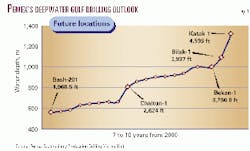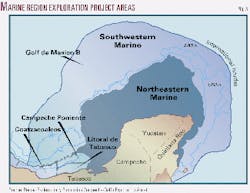Pemex anticipates deepwater gulf drilling program
Mexico's state-owned Petroleos Mexicanos plans to drill five deepwater exploratory wells in the Gulf of Mexico during the next 7-10 years, a company official indicated at a deepwater technology conference in Houston in mid-September.
The five wells would be drilled in just under 600 m to nearly 1,400 m of water (Fig. 1), and the speaker did not identify all of their locations.
Reporters were banned from the presentation by Rafael Navarro III, a petroleum engineer for Pemex Exploration & Production, at the 5th Annual Deepwater Technologies & Developments Conference presented by Strategic Research Institute. But copies of his slide presentation were in the book of proceedings provided to attendees.
That material outlined Pemex's long-term plans to explore and develop its side of the Gulf of Mexico in 200 m of water and beyond, which comprises 66% of Mexico's eastern offshore area.
Deepwater program
Pemex has divided the Mexican gulf's deepwater reaches into three areas.
The 280,000 sq km Offshore Northern Region extends from the Rio Grande-Veracruz coast seaward to the Southwestern Marine Region (Fig. 2).
The Northeastern Marine Region hugs the coast from Tabasco around the Yucatan Peninsula to Quintana Roo state and covers 166,000 sq km. It extends out to the Cretaceous shelf margin at about 200 m of water. And the Southwestern Marine Region lies seaward of the Northeastern Marine Region and extends from Coatzacoalcos to the US marine border and south to the Belize border, for a total of 352,000 sq km (Fig. 3).
In preparation for the deepwater drilling program, Navarro said, Pemex officials are working to:
- Improve their knowledge of petroleum system elements in order to reduce risks.
- Improve seismic processing and develop skills for subsalt seismic interpretation.
- Continue acquisition of 3D seismic data in strategic deepwater zones.
- Undertake elaborate new studies of seabed samplings.
Deep waters on the Mexican side of the gulf are far less explored and tested than the US deepwater frontier. But that area is thought to hold significant future potential oil and gas reserves for the growth of the Mexican economy and for the broader North American market.
Like the US sector, the Mexican side of the gulf has thick sediments with many oil and gas traps. But analysts say Mexico will need to expand investment or open itself to third-party activity to exploit those deeper waters.
Offshore experience
Most of Pemex's offshore experience has been in shallower water so far. It has completed only 20 wells in 100 m of water or more.
Mexico's deepest offshore well, Chuktah-1, was drilled during January-August 1999 in 384 m of water in the Gulf of Campeche under a turnkey drilling contract by Industrial Perforadora de Campeche. That apparently subsalt well was part of the Campeche-Poniente project, aimed at further exploration of a 7,500 sq km area over the next 2-5 years (Fig. 3). That area includes 19 field discoveries-only 10 of which are now producing-in less than 100 m of water.
However, the deep waters of that zone in the Gulf of Campeche have an undiscovered potential resource estimated at nearly 7.3 billion boe. Pemex has already identified three exploratory prospects in more than 300 m of water that it plans to drill in 2004-05.
Chuktah-1 produced 23 degrees gravity oil but was noncommercial. However, Navarro said in his prepared material, "Since the drilling cost is the key issue in deep water, the knowledge obtained on this first experience is very important." He said Chuktah-1 "established continuity of the proved petroleum system in water depths of less than 100 m."
Navarro also noted, "The results were not totally positive. The problems during the drilling of the salt bodies disallowed the test of the Mesozoic rocks. At this moment, turnkey contracts forbid drilling more than 500 m of salt. This problem can limit the exploration and exploitation of subsalt plays in the future."
Lessons to learn
Under the heading of "Lessons learned," Navarro indicated that Pemex officials need to:
- Gain more knowledge of metocean (sea, wind, and wave) conditions in the Mexican Gulf of Mexico.
- Use bigger-diameter tools to drill the first stage of deepwater wells, rather than the ones commonly used in Mexico.
- Develop new processes to select and contract service companies.
- Learn more about methods and technologies to deal with shallow-water zones.
- Correct logistic methods to allow continuous operation.
- Develop skills to both drill and complete wells through salt domes.
"Refining [a] work team is fundamental to the success of this type of operation," he emphasized.
Pemex also has designated a Gulf of Mexico "B" project to explore an area designated as its Southwestern Marine Region. The region, whose outside boundary abuts the international border, has an estimated undiscovered potential of 50.3 billion boe, "mostly in Tertiary locations," Navarro noted.
Pemex officials have divided that area into three sectors, with 109 total exploratory opportunities already identified. The first sector, in 500-1,000 m of water, includes 12 exploration projects of 40 sq km each, Navarro's prepared remarks disclosed.
Pemex also has mid to long-term plans to develop a Northern Offshore Region that extends along Mexico's upper coast to the US offshore boundary extending from the tip of Texas.
Navarro described it as an "area of great potential, given the present production in the Mesozoic Mexican plays and the Tertiary American plays of the Gulf of Mexico and the sea-bed sampling studies." But he noted it is a high-risk area for Pemex "due to lack of knowledge of some oil system elements."
He said, "Availability of state-of-the-art technologies is the key to its successful exploitation."
Included in that area is the Perdido fold belt near the US marine boundary, which US analysts have previously said may offer one of the best opportunities for participation by major international oil companies in Mexico's offshore development. One US source familiar with Mexican geology said Pemex's stylized map probably overstates Perdido's extent in Mexico (Fig. 2).
Navarro's material said that region has an estimated undiscovered potential of 35 billion boe. That area also includes the Rio Grande River delta, a predominantly gas-producing zone in 200-1,000 m of water.
Government concerns
Navarro's prepared material indicated Pemex must seek "different financial strategies, in conjunction with the government" to advance drilling and production technology and to develop deepwater projects.
US analysts say the election of Vicente Fox and his center-right National Action Party this summer may speed liberalization of the Mexican energy sector.
During his election campaign, Fox pledged his government would not try to privatize Pemex, which is protected by the Mexican constitution and is both the largest nongovernment employer and the biggest source of government revenue. But with his business background, Fox reportedly wants to see Pemex operate less like a state monopoly and more like a competitive international oil company (OGJ Online, July 21, 2000).



